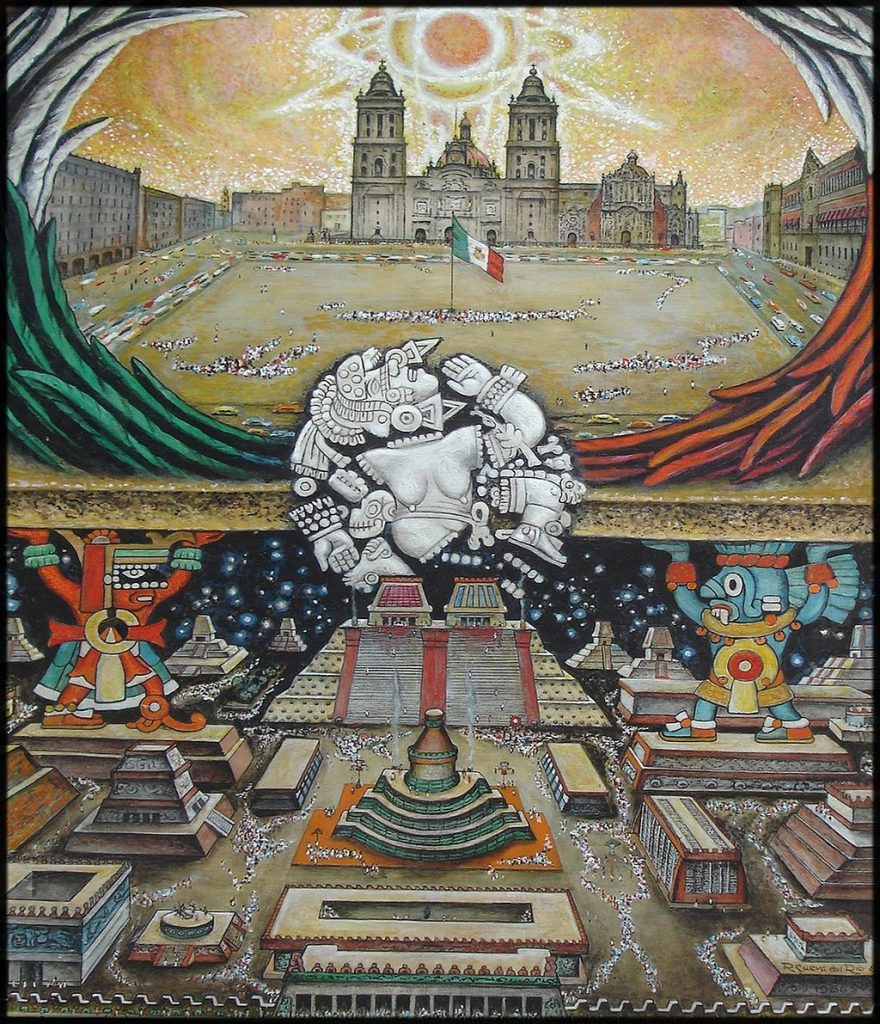When the Spanish conquistadors arrived in the valley of Mexico, they discovered something mystical. They viewed this place as the Venice of the New World. There were glamorous pyramids, exceptionally clean streets, grand aqueducts, lavish ball courts… all floating on a lake. This magical city, known as Tenochtitlan, was built by the Aztecs, the same group of people many look down upon because of their brutality, ferocity, and their practice of human sacrifice. Though many view the Aztecs as cold-hearted murderers, this is not the full story. Yes, they did practice human sacrifice, but much like other civilizations, they also had art, building projects, literature, religion, and a rich culture. But how is it that these people became a superpower of the Americas?
According to legend, the Aztecs, also known as the Mexica, hailed from a beautiful place known as Aztlan, which means “Land of the cranes.” Much like the mythical Greek city Atlantis, no one really knows where Aztlan is or even if it existed. In fact, the Aztec story about Aztlan is only one of several origin stories they tell. One legend has it, however, that one day their god, Huitzilopochtli, told the Mexica people to leave their land and find a new home, and they did. After more than two centuries of migrating, the Mexica grew more and more desperate to find that new home. Then they discovered the valley of Mexico. But they weren’t the only ones to settle there. Tribes such as the Azcapotzalco, the Culhuacán, and the peoples of Texcoco had gotten there long before they had. The only land that was still available to the Mexica was the nasty marshlands around Lake Texcoco, which the others had not wanted. And yet it was here that the Mexica had a vision. It was here that their sun god Huitzilopochtli gave them a sign: an eagle perched on a cactus eating a snake. That is why Mexico’s flag today has an eagle eating a snake. It meant that the Mexica (the Aztecs) had finally found their new home.1
Settling down in the Valley of Mexico was anything but easy. For one thing, objects would sink easily in the poor marshy grounds, which were in the middle of Lake Texcoco; yet this is where the Aztec’s creative engineering would come into play. Under their leader Tenoch, from which the name Tenochtitlan comes, the Aztecs began building their new home, by trading waterfowl and fish for wood and stone from the other tribes.2 With the wood, they made stakes, which were driven into the marshy ground. They then filled the gaps in between the stakes with mud and stones, which would become a foundation for their city. In order to connect the island city to the mainland regions, they also made gigantic causeways, using the same principles for making their foundation and were several miles long. Another problem was the water in Lake Texcoco, which was salty. The Aztecs had to build an aqueduct that would transport fresh water from the distant Chapultepec hills to the city itself. This aqueduct used a pair of stone pipelines that used gravity to transport the water to the city, and parts of it still stand to this day.3 Though they fixed their foundation and their water problems, there was still one problem that the Aztecs had to face before they could become the dominant force of Mesoamerica.
As their population kept growing, the demand for food kept rising at an alarming rate, and this is where the Aztecs are distinct from other civilizations. First, they dug canals into the island’s marshes and chopped down the plants that were growing there. They then piled reeds on top of each other to make rafts and covered them with mud. Finally, they planted willows underneath the rafts to anchor them. And voilà, the Aztecs had their very own artificial floating gardens, known as chinampas. With water always available, these chinampas could produce crops year round, thus the Aztecs had an abundance of beans, corn, tomatoes, squash, and flowers.4

After several generations, Tenochtitlan became a city of wonder and reached a population of around 200,000 inhabitants, making it one of the largest cities in the world.5 The city was decorated with structures, such as the serpent wall that enclosed the sacred quarters of the city and contained the carvings of snakes. It also contained lavish temples, such as the temple of Xipe Totec and the temple of Quetzalcoatl, the god of the sky and wind. But at the heart of Tenochtitlan was an impressive sight to see. This magnificent edifice, known as the Templo Mayor, was a temple like no other. This 150 feet pyramid had a twin staircase that led up to the glamorous temples of Tlaloc, the rain god, and Huitzilopochtli, the same god who provided the Aztecs with the vision of their new home.6

In the Aztec tongue, Nahuatl, their word for city is actually two words in English: water mountain (atl tepetl).7 In many ways, Tenochtitlan was a mighty mountain that watched over the valley of Mexico with its striking glare. Long before Mexico City became a glimpse in the eyes of history and replaced this magnificent place, Tenochtitlan was a flourishing capital that was not necessarily built by a brutal and violent race. But rather by a people who didn’t let the impossible stop them from making their home a legendary reality.
- Jennifer Stock, “Tenochtitlán Is Founded,” Global Events: Milestone Events Throughout History, (Farmington Hills, MI: Gale, 2014), 23-24. ↵
- Jennifer Stock, “Tenochtitlán Is Founded,” Global Events: Milestone Events Throughout History, (Farmington Hills, MI: Gale, 2014), 23-24. ↵
- Sonia Benson, “The Rise of the Aztecs,” Early Civilizations in the Americas, Vol. 2 (Detroit: UXL, 2005), 465. ↵
- Sonia Benson, “The Rise of the Aztecs,” Early Civilizations in the Americas, Vol. 2 (Detroit: UXL, 2005), 461-462. ↵
- Sonia Benson, “The Rise of the Aztecs,” Early Civilizations in the Americas, Vol. 2 (Detroit: UXL, 2005), 461. ↵
- Charles Phillips, Aztec and Maya: The Complete Illustrated History: The Greatest Civilizations of Ancient Central America with 1000 Photographs, Paintings and Maps (New York: Metro Books, 2008), 430-431. ↵
- Charles Phillips, Aztec and Maya: The Complete Illustrated History: The Greatest Civilizations of Ancient Central America with 1000 Photographs, Paintings and Maps (New York: Metro Books, 2008), 56-57. ↵




43 comments
Luisa Ortiz
I love your article! what an amazing way of putting Mexico’s name up high! there were many lines in your article that made my Mexican heart jump of happiness, I loved how you describe and explain that Aztecs were more than just human sacrifices! The pictures you choose were good! congratulations on this article and thank you again for such inspiring words!
Lilliana Canales
I personally believe that the Aztecs only said they came from another land in order to make citizens believe them and willing be under their control. The Aztecs were of course notorious for their human sacrifices but they accomplished a lot architectural wise and you provided perfect images to exhibit their temples.
Mia Stahl
It has always amazed me that so many ancient peoples around the world have placed so much trust in the god they believed in. Although that occurrence is not totally lost on the people of America because of the immense faith that we place in our God. The symbol of the eagle with the snake in its mouth is one that is infamous and the origin story is that much more so.
Kathyleen Lauriano
It was truly inspiring that they didn’t let anything stop them from living where they wanted. It goes to show that they were hard working and determined. They were very clever and smart. Its interesting how they came up with such creative ways to live. This article did really good in showing their creativity and way of life. It was well written and caught my attention from the very beginning.
Maggie Amador
I remember learning about the creation of chinampas in high school and It is still very interesting how innovative the Aztecs were for their time. I love that the Aztecs were able to create a thriving civilization out of land that was rejected by everyone else. From the description, Tenochtitlan truly does sound magical and I hope one day I’ll be able to visit one of the many wonders of Mexico.
Clarissa Gonzalez
Religion is something completely foreign to me. I grew up in a Catholic household, but we rarely practiced what we preached, which led to me identifying with nothing rather than something. Seeing a group of people give up something as valuable as fertile land just because their God tells them to is so odd to me, but still understandable in a sense. It’s always nice to have something to believe in. The Aztec people are just like so many people today, and that doesn’t make what they did dumb or unreasonable, it’s just their way of believing.
Julissa Cantu
This particular article was very educational as people have their own perceptions of who the Aztecs were and how they lived. This is the case with most indigenous cultures all over the globe, where modern-day people have a tendency to believe indigenous individuals were more savage than they actually were. The creations the Aztecs made in order to survive, such as the water cleaning device, was an amazing feat that people have a tendency to ignore or create wild, off-based conspiracy theories.
Pamela Callahan
I find the ingenuity of the early civilizations, such as the Aztecs, to be very fascinating. I have heard the story of the eagle eating the snake on the cactus before, and I’ve heard of the city of Tenochtitlan in the past, but I had no idea how highly complex the design of the city really was. This was an eye-opening article and I think it did a great job painting a picture of how the city was built and the systems and processes the people developed there to keep it running smoothly.
Lyzette Flores
It was nice to find out how the eagle eating the snake came upon the Mexican flag. It goes to say that it was based upon never giving up until you find what you are looking for. The Mexica struggled until they found a place and that is really inspiring to hear. Personally, I would like to visit templo mayor to see for myself the beautiful architect now that I know some history behind it.
Hailey Rodriguez
Before reading this article I had never heard of this story. I had no idea the Aztecs had such a hard time searching for land and traveling for many years. It is inspiring that they would not let that be a challenge to them and that they kept going and were determined to make the best of what they had until they found better. This story of the mountain and its significance, as well as the Aztec people, is very interesting